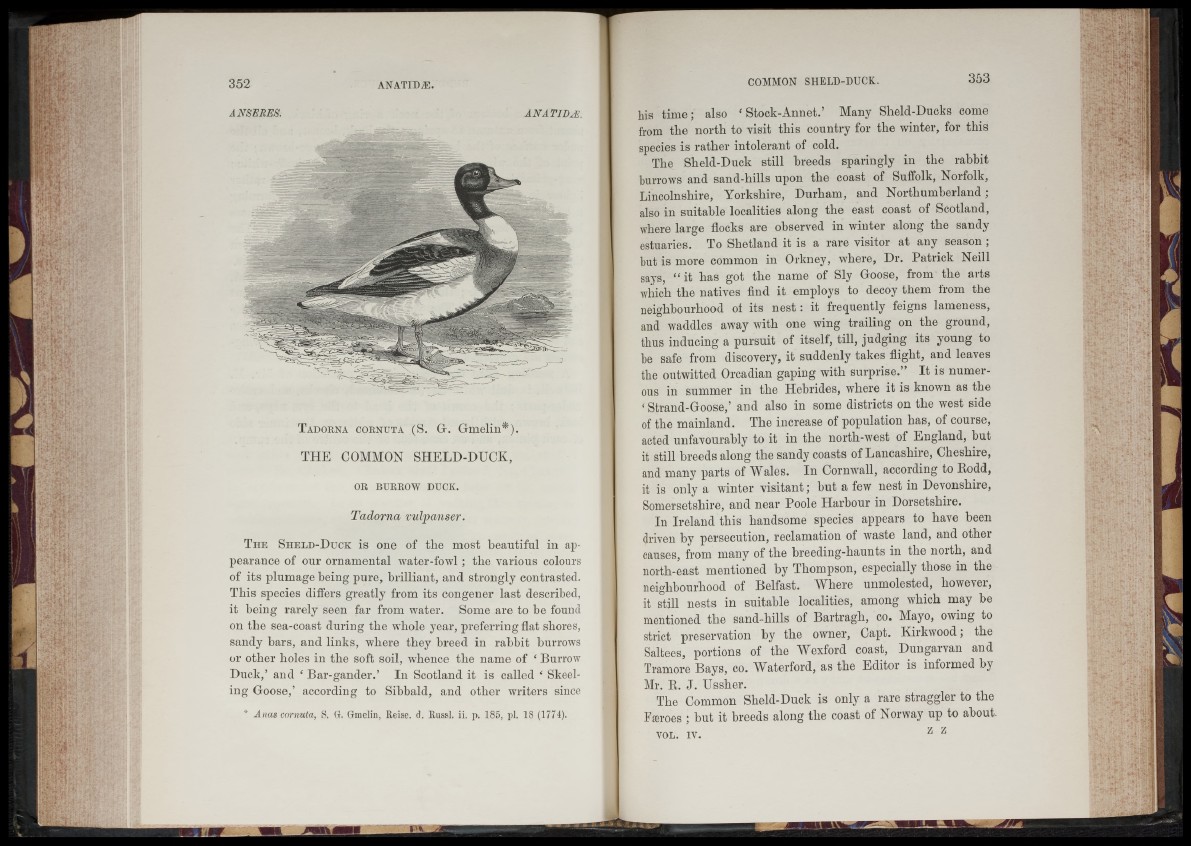
T h e S h e l d -D uck is one of tlie most beautiful in appearance
of our ornamental water-fowl; the various colours
of its plumage being pure, brilliant, and strongly contrasted.
This species differs greatly from its congener last described,
it being rarely seen far from water. Some are to be found
on the sea-coast during the whole year, preferring flat shores,
sandy bars, and links, where they breed in rabbit burrows
or other holes in the soft soil, whence the name of ‘ Burrow
Duck,’ and ‘ Bar-gander.’ In Scotland it is called ‘ Skeel-
ing Goose,’ according to Sibbald, and other writers since
* Anas carrmta, S. Gr. Grmelin, R e is e . d. R u ssl. ii. p. 1 8 5 , p]. 1 8 (1 7 7 4 ).
COMMON SHELD-DUCK. 353
his time; also ‘ Stock-Annet.’ Many Sheld-Ducks come
from the north to visit this country for the winter, for this
species is rather intolerant of cold.
The Sheld-Duck still breeds sparingly in the rabbit
burrows and sand-hills upon the coast of Suffolk, Norfolk,
Lincolnshire, Yorkshire, Durham, and Northumberland;
also in suitable localities along the east coast of Scotland,
where large flocks are observed in winter along the sandy
estuaries. To Shetland it is a rare visitor at any season ;
but is more common in Orkney, where, Dr. Patrick Neill
says, “ it has got the name of Sly Goose, from the arts
which the natives find it employs to decoy them from the
neighbourhood of its nest: it frequently feigns lameness,
and waddles away with one wing trailing on the ground,
thus inducing a pursuit of itself, till, judging its young to
be safe from discovery, it suddenly takes flight, and leaves
the outwitted Orcadian gaping with surprise.” It is numerous
in summer in the Hebrides, where it is known as the
‘ Strand-Goose,’ and also in some districts on the west side
of the mainland. The increase of population has, of course,
acted unfavourably to it in the north-west of England, hut
it still breeds along the sandy coasts of Lancashire, Cheshire,
and many parts of Wales. In Cornwall, according to Rodd,
it is only a winter visitant; but a few nest in Devonshire,
Somersetshire, and near Poole Harbour in Dorsetshire.
In Ireland this handsome species appears to have been
driven by persecution, reclamation of waste land, and other
causes, from many of the breeding-haunts in the north, and
north-east mentioned by Thompson, especially those in the
neighbourhood of Belfast. Where unmolested, however,
it still nests in suitable localities, among which may be
mentioned the sand-hills of Bartragli, co. Mayo, owing to
strict preservation by the owner, Capt. Kirkwood; the
Saltees, portions of the Wexford coast, Dungarvan and
Tramore Bays, co. Waterford, as the Editor is informed by
Mr. R. J. Ussher.
The Common Sheld-Duck is only a rare straggler to the
Fseroes ; but it breeds along the coast of Norway up to about.
VOL. IV. z z